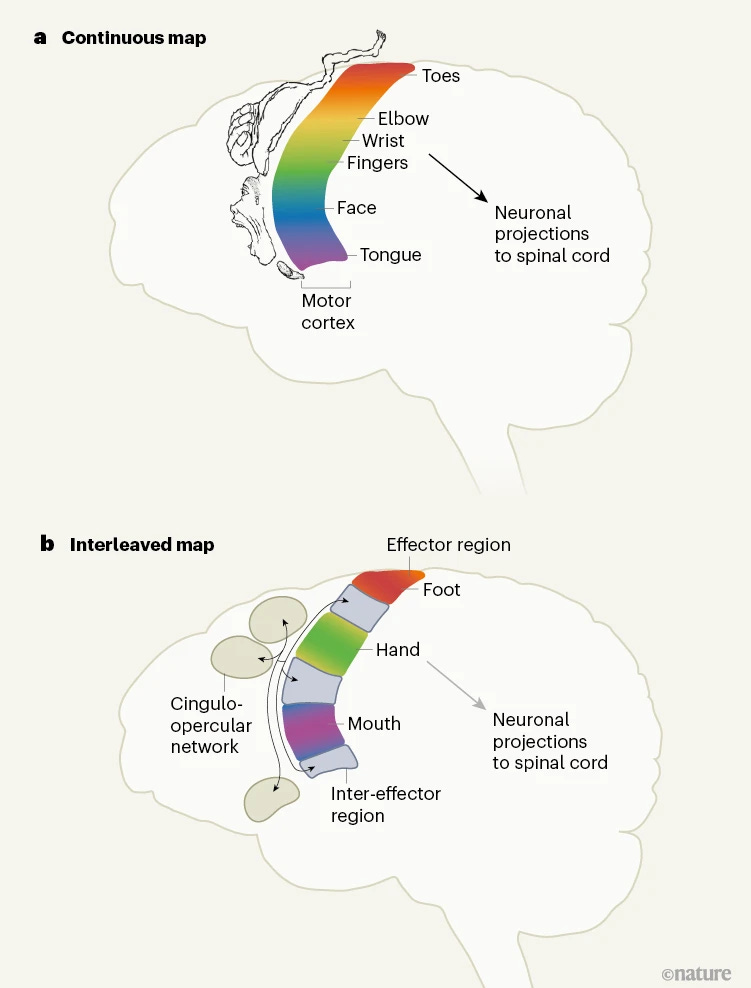Sci-Ed Update 269
eDNA (environmental DNA), Hand gestures for accurate listening, Storytelling, Redrawing the cortex map, Telemeres & longevity, Bears & thrombosis insights, Memories in membranes, Glymphatics
You shed DNA everywhere you go
– trace samples in the water, sand and air are enough to identify who you are, raising ethical questions about privacy

Human DNA can be sequenced from small amounts of water, sand and air in the environment to potentially extract identifiable information like genetic lineage, gender, and health risks, according to our new research.
Every cell of the body contains DNA. Because each person has a unique genetic code, DNA can be used to identify individual people. Typically, medical practitioners and researchers obtain human DNA through direct sampling, such as blood tests, swabs or biopsies. However, all living things, including animals, plants and microbes, constantly shed DNA. The water, soil and even the air contain microscopic particles of biological material from living organisms.
DNA that an organism has shed into the environment is known as environmental DNA, or eDNA. For the last couple of decades, scientists have been able to collect and sequence eDNA from soil or water samples to monitor biodiversity, wildlife populations and disease-causing pathogens. Tracking rare or elusive endangered species through their eDNA has been a boon to researchers, since traditional monitoring methods such as observation or trapping can be difficult, often unsuccessful and intrusive to the species of interest.
Read more→ AandP.info/wbh
How hand gestures alter the perception of your speech
Research has found that words are more accurately heard when accompanied by hand gestures.
A team of researchers from the Netherlands found that hands gestures, when used strategically, influence how certain words are heard.
Participants were 20% more likely to hear and interpret the words being spoken when accompanied by a matching hand gesture, and 40% as likely to hear the wrong word when the gestures did not match.
Previous research has suggested that certain hand gestures can signal extraversion and dominance, and that speaking with gestures in general tends to lead to being evaluated as warm, agreeable, and energetic.
Kevin Patton comment→ As teachers, we can use gestures as a tool to improve communication and understanding.
Read more→ AandP.info/eyd
Storytelling, Featuring the Actin-Myosin Love Story | TAPP 130
Host Kevin Patton revisits some classic segments from past episodes. In the first segment, he explains why he thinks storytelling is the heart of effective teaching. Then. he tells a brief version of his actin-myosin love story—a playful analogy to help students learn about muscle contraction.
To listen to this episode, click on the player (if present) or this link→ lnns.co/GzMLloctVYm
A redrawn map for the human motor cortex

The human brain’s motor cortex is often regarded as a linear map with discrete sections, each controlling different parts of the body. The discovery that portions of the motor cortex have other functions points to a different type of map.
How does our brain control everyday behaviours, such as grasping a cup of coffee or telling a joke? A century of experimental neurology testifies that a thin strip of motor cortex running sideways down the outer surface of the brain translates voluntary actions (the decision to take a sip, for instance) into muscle movements. This strip is usually thought of as representing a continuous map of the human body, with separate sections each containing neurons that contact the spinal cord to operate a particular group of muscles.
‘Higher’ regions of the brain act as puppeteers, orchestrating movements by creating appropriate spatio-temporal sequences of neuronal activity in the motor-cortex map.
Writing in Nature, Gordon et al.1 provide a modified portrait of human motor-cortex organization, showing that the cortex is a composite of two distinct and spatially interleaved systems, only one of which is devoted directly to bodily movements.
Read more→ AandP.info/ny1
In a Surprise, Ultra-Long Telomeres Do Not Lead to Longevity
Recent studies are changing what scientists have long thought about telomeres, which are repetitive sequences of DNA that cap the ends of chromosomes. Telomeres get shorter with each round of cell division, until they cannot get any shorter and at that point, cells stop dividing. Telomeres are thought to be closely linked to aging and certain diseases.
New research has studied seventeen individuals from five different families who carried mutations in a gene called POT1, which is associated with telomeres. The unusually long telomeres seen in these individuals do not confer longevity; instead, carriers of these mutations tend to get certain types of tumors and a disorder called clonal hematopoiesis. The research has been reported in New England Journal of Medicine.
"Our findings challenge the idea that long telomeres protect against aging," noted study co-author Mary Armanios, M.D., a professor at Johns Hopkins University School of Medicine, among other appoinments. "Rather than long telomeres protecting against aging, long telomeres allowed cells with mutations that arise with aging to be more durable."
Read more→ AandP.info/koz
What a Study of Hibernating Bears Tells Us About Deep Vein Thrombosis
There’s a paradox that’s well known in vascular medicine. Patients who find themselves temporarily immobilized—after being placed on bed rest, for example, or while recovering from surgery or an injury—are at risk of a blood clot developing in a deep vein, typically in a leg. But people who are chronically immobilized after a spinal cord injury or a stroke don’t have the same heightened risk of deep vein thrombosis, or DVT, after the early phase.
To investigate what protects the latter, a team of scientists in Europe turned to a novel animal model: hibernating brown bears. Their findings, published recently in Science, suggest that a protein that’s downregulated on platelets during extended periods of little movement—not just in bears, but also in people and pigs—could be a key factor.
The Centers for Disease Control and Prevention estimates that in the US alone, DVT and pulmonary embolism, together known as venous thromboembolism (VTE), affect as many as 900 000 people every year and cause 60 000 to 100 000 annual deaths. About a third of people who have a DVT will have long-term complications and the same proportion will experience a recurrence within a decade. Immobilization, which slows blood flow, is one of many risk factors for DVT. Measures to prevent venous blood clots, specifically anticoagulants and compression garments, although effective, don’t always work and can induce bleeding.
Read more→ AandP.info/1so
Memories may be stored in the membranes of your neurons, suggests study
Although neuroscientists have identified different regions of the brain where memories are stored, such as the hippocampus in the middle of the brain, the neocortex in the top layer of the brain and the cerebellum at the base of the skull, they have yet to identify the specific molecular structures within those areas involved in memory and learning.
Research from our team of biophysicists, physical chemists and materials scientists suggests that memory might be located in the membranes of neurons. The work is published in the journal Proceedings of the National Academy of Sciences.
Since scientists think the main way the brain processes and stores information is through these long-term changes to the synapses, we wondered if memory might be stored in the membrane's lipid bilayer.
We found that exposing a model of a simple lipid bilayer to electrical stimulation—not unlike the stimulation used in studies of the brain—can trigger long-term changes. What made this result unique was that we were able to generate changes in our simple membrane model without the neuronal proteins typically associated with it. Furthermore, long-term plasticity persisted in our model for almost 24 hours without any further electrical stimulation. This suggests that the neuronal membrane may be responsible for memory storage.
Read more→ AandP.info/4vp
Insight into brain's waste clearing system may shed light on brain diseases

Like the lymphatic system in the body, the glymphatic system in the brain clears metabolic waste and distributes nutrients and other important compounds. Impairments in this system may contribute to brain diseases, such as neurodegenerative diseases and stroke.
A team of researchers in the McKelvey School of Engineering at Washington University in St. Louis has found a non-invasive and non-pharmaceutical method to influence glymphatic transport using focused ultrasound, opening the opportunity to use the method to further study brain diseases and brain function. Results of the work are published in the Proceedings of the National Academy of Sciences on May 15.
Read more→ AandP.info/g21






